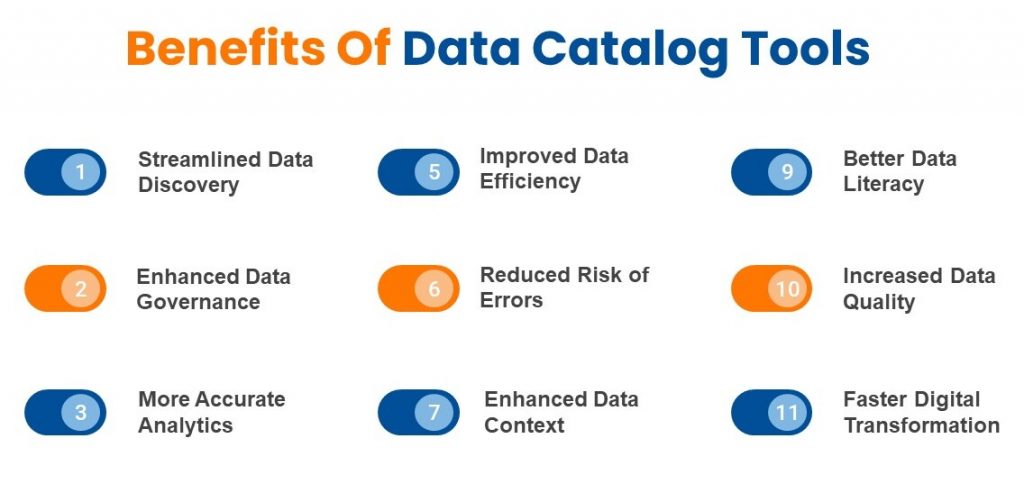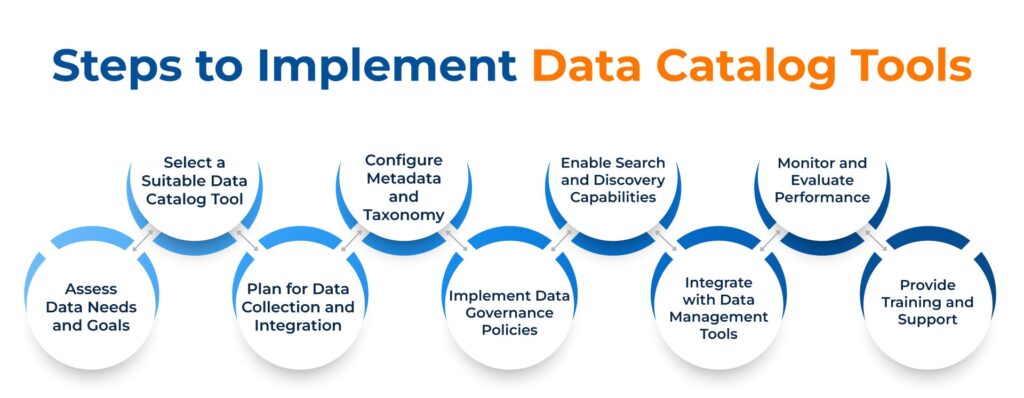Did you know that businesses lose an average of 12% of their revenue each year due to poor data quality? This amounts to a staggering $600 billion for businesses across the US. That’s a huge loss! Wouldn’t it be great to have tools that could help you find the data you need easily and quickly, understand what it means, and ensure it’s accurate and reliable? This is where data catalog tools come in.
It’s no surprise that many organizations these days are immersed in information and are facing challenges with untidy data sources and isolated systems. Effective data discovery, governance, and utilization are hampered by this fragmented data. Data catalog tools act as a compass that helps discover, understand, and utilize your data assets effectively.
In this detailed guide, we’ll discuss the different data catalog tools, exploring their significance, functionalities, and their role in helping businesses navigate the data deluge with confidence and clarity.
What Are Data Catalog Tools?
A data catalog is a centralized inventory or index that organizes and describes metadata, providing insights into an organization’s data assets. It acts as a roadmap, allowing users to discover, understand, and access data efficiently.
Data catalog tools provide a unified view of all data assets within an enterprise, encompassing various data sources like data lakes, warehouses, NoSQL databases, and cloud storage. These tools organize inventories, manage metadata, and enhance business data by collecting, managing, and enriching it. They play a crucial role in data governance, compliance, and data analysis by automating processes, leveraging metadata, and facilitating easy analysis of large datasets.

The Significance of Data Catalog Tools
The global market for data catalog was at $0.7 billion in 2022 and is expected to reach $1.8 billion by 2027, growing at a CAGR of 22% during this period. This rapid growth highlights the growing importance of these tools in the modern data landscape.
Data catalog tools help organizations overcome the challenges of data fragmentation, poor data visibility, and inefficient data discovery, enabling better data-driven decision-making by providing a centralized repository of data assets.
Naturally, the business value of data catalog tools can be quantified in terms of improved data accessibility, reduced data management costs, and enhanced data-driven decision-making.

8 Key Features of Data Catalog Tools
1. Connectors to Various Data Sources
Data catalog tools act as connectors that help enable seamless integration with diverse data repositories such as databases, data lakes, cloud storage, and APIs. Moreover, they facilitate data ingestion and extraction from multiple sources for comprehensive data cataloging.
2. Metadata Management Tools
These tools capture and store metadata information of the data assets, including descriptions, tags, lineage, and usage statistics. Effective metadata management also ensures high data quality, consistency, and accuracy.
3. AI and Machine Learning Algorithms
Data catalog tools utilize AI and ML algorithms to automate data classification, enrichment, and recommendation of relevant data assets. These intelligent algorithms help improve data discovery and analysis based on data relevance and accessibility.
4. Business Glossary
Data catalog tools define and maintain a common business vocabulary to standardize data terminologies and ensure consistent understanding across the organization. These tools link technical metadata to business terms for better alignment between IT and business users.
5. Data Lineage Functions
This involves tracking the origin and transforming data from its source to its destination. Data catalog tools provide visibility into data flow, dependencies, and transformations for better data governance and compliance.
6. Search Capabilities
These tools offer exceptional search functionalities that’ll help locate and access relevant data. They enable users to search based on metadata attributes, tags, keywords, and other criteria for efficient data discovery.
7. Collaboration Tools
These tools facilitate collaboration among various data professionals, such as data users, data stewards, and data analysts for sharing insights, feedback, and knowledge. They support annotations, comments, and data sharing features for enhancing teamwork and data-driven decision-making.
8. Integrated Data Governance
By enforcing data governance rules within the catalog, these tools ensure compliance with data regulations and policies. Data catalog tools help enable data lineage tracking, access controls, and data quality monitoring for effective data governance and security.
Read More – What Is Microsoft Purview: The Key to Unlocking Effective Data Governance

Benefits of Data Catalog Tools
The implementation of data catalog tools can bring a wealth of benefits to organizations, including:
1. Streamlined Data Discovery
Data quality and data catalog tools work together to help find the best data sets for projects, assess data quality, and evaluate data that may not have been tagged manually, streamlining data discovery processes.
2. Enhanced Data Governance and Compliance
Organizations can maintain data security, privacy, and regulatory compliance with centralized data management and policy enforcement.
3. More Accurate Analytics
Data catalog tools enhance the accuracy of analytics by providing a unified view of all data assets and improving data context.
4. Improved Data Efficiency
These tools help in finding data easily, avoiding duplication, understanding data better, ensuring data rules are followed, and encouraging teamwork, leading to improved data efficiency.
5. Reduced Risk of Errors
Data catalogs reduce errors by offering quality data information, detailed descriptions, tracking data history, complying with metadata rules, promoting teamwork, limiting access, and assisting with data preparation, leading to more accurate data handling and reduced errors.

6. Enhanced Data Context
These tools boost data understanding by providing detailed information about datasets, including their origins, quality, usage, and connections to other datasets, facilitating better decision-making and analysis.
7. Better Data Literacy and Collaboration
Data catalog tools can foster a data-driven culture by promoting data literacy and enabling cross-functional collaboration. Users can share insights, contribute to data curation, and engage in discussions around data assets, leading to a more informed and empowered workforce.
8. Increased Data Quality and Reliability
Integration with data quality management tools allows data catalog solutions to assess and monitor the health of data assets, ensuring the reliability and trustworthiness of the information used for decision-making.
9. Accelerated Digital Transformation
By providing a centralized and comprehensive view of an organization’s data assets, data catalog tools can be a foundation for successful digital transformation initiatives. They enable organizations to unlock the full potential of their data, driving innovation, improving customer experiences, and gaining a competitive edge.

Top 10 Data Catalog Tools That Can Transform Your Business
The data catalog tool market is populated with a diverse array of solutions, each offering unique features and capabilities. Some of the leading players include:
1. Alation Data Catalog
It provides a user-friendly, intuitive interface, improved search options, and team-oriented data curation. More than four hundred organizations around the world, including Pfizer, Salesforce, and Intuit use Alation Data Catalog.
2. Collibra Catalog
It is a comprehensive data governance solution with strong capabilities in data lineage, impact analysis, and data stewardship. UBS, Fannie Mae, and Eli Lilly are some of the top companies that use Collibra Catalog.
3. Informatica Enterprise Data Catalog
This catalog tool uses artificial intelligence (AI) and machine learning capabilities for automating the identification and classification of information It seamlessly integrates with a wide range of Informatica’s other data management products, enabling smooth running of enterprise wide governance programs on data quality.
4. Talend Data Catalog
This tool combines data catalog, data preparation, and data governance capabilities in a unified platform. It supports a wide range of data sources and formats, making it a great choice for organizations with diverse data landscapes.
5. Zeenea
Zeenea is a cloud-native tool designed to help companies manage their metadata, including user experience, discovery, and self-service. It serves customers across various industries, including financial services, healthcare, and manufacturing.
6. Ataccama Data Catalog
It offers a robust data catalog with advanced features like automated data classification, data quality management, and data lineage visualization. It easily Integrates with Ataccama’s broader data management suite.
7. Dataedo
Dataedo is ideally suited for SMEs owing to its ease of installation requirements or unboxing and easy steps after which one can begin using. Many other small enterprises have adopted Dataedo because its purpose is specifically designed for low-scaled businesses, hence offering the perfect solutions needed by these kinds of businesses.
8. OvalEdge
OvalEdge is a cloud-based data catalog that focuses on data discovery, quality, and governance. It comes with several pre-built connectors for various sources of data.
9. Select Star
It’s a data catalog tool that utilizes machine learning and natural language processing to enable efficient data discovery and exploration. It offers a clean, intuitive user interface and seamless integration with cloud data platforms.
10. AWS Glue Data Catalog
It is a fully managed metadata repository provided by Amazon Web Services (AWS) that stores metadata about data assets, making it easier to discover, manage, and analyze data. It integrates with a wide variety of data sources and supports AI-powered data discovery.

Implementing Data Catalog Tools
The steps for implementing data catalog tools are as follows:
1. Assess Data Needs and Goals
The implementation of data catalog tools in your business operations begins with assessing your organization’s data needs and objectives. Identify the types of data that need to be cataloged, such as structured, unstructured, or semi-structured data. Determine the key stakeholders and departments involved in data management to understand their specific requirements.
2. Select a Suitable Data Catalog Tool
Make sure that you choose the right data catalog tools for your business by researching and comparing different data catalog tools available in the market. Consider factors like scalability, compatibility with existing systems, user-friendliness, and cost. Choose a tool that aligns with your organization’s needs and budget.
3. Plan for Data Collection and Integration
This step involves defining the data sources that will be cataloged, such as databases, data lakes, or cloud storage. Develop a proper strategy for integrating data from these sources into the catalog tool while ensuring good data quality and consistency.

4. Configure Metadata and Taxonomy
Establish a metadata framework that outlines the qualities and attributes that should be recorded for every data asset. Organize data assets according to business domains or types of data by creating a taxonomy or categorization system. Set up the data catalog tool so that the specified framework and taxonomy are followed when capturing and storing metadata.
5. Implement Data Governance Policies
Develop data governance guidelines for compliance, security, privacy, and data access. To maintain data integrity and enforce governance guidelines, incorporate these principles into the data catalog tool. Educate stakeholders and users on data governance best practices and their responsibilities for preserving data quality.
6. Enable Search and Discovery Capabilities
Set up the search functionality for the data catalog tool to help users locate and learn about data assets. Use metadata-driven search options, filters, and tags to get more accurate results. Provide dashboards and user interfaces that are easy to use, allowing users to browse the library and get the information they need.
7. Integrate with Data Management Tools
Integrate the data catalog tool with data governance platforms, data lineage tools, data quality tools, and other data management tools. To streamline data management procedures, make sure there is seamless data flow and interoperability across different systems.
8. Monitor and Evaluate Performance
Establish monitoring systems to assess effectiveness and usage of the data catalog tool. Get feedback from customers to determine areas that need improvement. Review and update the taxonomy, policies, and metadata of the catalog on a regular basis to reflect the changing data needs.
9. Provide Training and Support
Provide users with training sessions to acquaint them with the functionality of the data catalog tool. Offer ongoing support and troubleshooting assistance to address user queries and issues. Encourage user adoption by highlighting the benefits of using the data catalog for data-driven decision-making.

Best Practices for Implementing Data Catalog Tools
A well-implemented data catalog can significantly improve business performance by empowering users with analytical capabilities and providing them with the necessary information to evaluate the value of data for intended uses.
Here are the best practices for data catalog implementation:
1. Define Your Data Catalog Purpose and Scope
Before implementing a data catalog, it is essential to outline its purpose and scope. Identify the types of data to be included, who the intended audience is, and the business goals that the data catalog needs to achieve, such as improving data accessibility, enhancing data governance, and supporting analytics initiatives. A well-defined purpose and scope will guide the implementation process and help ensure that the catalog serves its purpose.
2. Identify and Involve Key Stakeholders
Successful implementation of a data catalog requires the involvement of key stakeholders, including data analysts, data scientists, IT teams, business users, and data stewards. Include them in the design and implementation process to gather insights, validate requirements, and ensure alignment with organizational goals.
3. Establish Data Governance Policies
Implementing a data catalog involves establishing efficient data governance policies to ensure the catalog remains accurate, up-to-date, and secure. These policies should cover data ownership, data quality, and data privacy. Having a strong data governance framework in place ensures that the data catalog remains trustworthy and accurate.
4. Data Classification and Organization
Classify and organize data properly in the catalog using descriptive, standardized naming conventions for data assets. Develop a data classification framework to categorize data assets based on sensitivity, criticality, business relevance, and usage. Define data classifications such as public, internal, confidential, and regulated data. Metadata, such as data descriptions, should be clear and easy to understand, facilitating data discovery for users.
5. Implement Data Lineage Tracking
Your data catalog should provide clear data lineage, which is the journey of data from its source through various transformations, including origins, transformations, and movement of data within the organization This helps in understanding data provenance, improves trust, and supports compliance by identifying sensitive data and ensuring it is properly protected
6. Regular Data Catalog Maintenance
A data catalog should be regularly updated and maintained. This involves keeping track of new data assets being created, changes to existing assets, and ensuring data quality. Regular maintenance and updates help ensure the catalog remains accurate, up-to-date, and trustworthy.
7. Promote Data Literacy Among Users
Promote a culture of data literacy within the organization by providing training, resources, and documentation on how to use the data catalog effectively. Educate users on data management best practices, metadata usage, data governance principles, and search techniques. Show users how the catalog can help them in their work and improve overall business strategies.
8. Enhance Search Functionality
Ensure the catalog has robust search functionality, making it easy for users to find the data they need. Implement advanced search capabilities such as keyword search, filters, facets, and metadata-driven search options. Ensure that search results are relevant, comprehensive, and easy to navigate. This includes using metadata to create an informative and searchable inventory of all data assets.
8. Foster Collaboration and Feedback
Encourage collaboration and feedback among users to improve the catalog’s effectiveness and usability. This includes setting up access controls to prevent unauthorized access and overcomplicating categorizations that can leave users bewildered. Also, enable features such as data annotations, comments, ratings, and user-generated tags to enhance collaboration and knowledge sharing.

Challenges and Considerations for Data Catalog Tools
1. Tool Selection
Choosing between custom-built solutions and third-party tools involves trade-offs in cost, labor, and time for acquiring, ingesting, and presenting data.
2. Data Accessibility and Governance
Ensuring comprehensive data coverage, maintaining data quality, and promoting data governance are crucial for effective data catalog usage.
3. Metadata Curation
Proper semantics, descriptions, categorization, and classification are essential for making metadata useful and easily discoverable within a data catalog.
4. Data Transformation Visibility
Data catalog tools should provide visibility into data transformations, including those hidden within ETL processes or programming languages, to understand data changes effectively.
5. Integration with Existing Systems
Seamless integration with various data sources and platforms is necessary for comprehensive data discovery and analysis.
6. User Adoption
Encouraging user adoption and providing training on catalog usage is critical for maximizing its benefits across the organization.
7. Scalability
As data volumes grow, the catalog must scale efficiently to handle increasing data complexities and demands.
8. Data Quality and Lineage
Ensuring data quality and providing clear data lineage information is vital for data trustworthiness and regulatory compliance.
9. AI and Automation
Leveraging AI and automation capabilities can enhance data catalog functionalities, such as automated metadata tagging and data classification.

Innovations in Data Catalog Tools
1. AI-Powered Data Discovery
Data catalog tools can automatically discover and classify data assets through AI and ML algorithms, thereby accelerating data exploration.
2. Automated Data Lineage
Advanced data catalog tools offer automated data lineage tracking, providing insights into the origins, transformations, and dependencies of data, enhancing data governance and compliance.
3. Data Catalog as a Service (DCaaS)
Cloud-based data catalog services offer scalability, flexibility, and cost-effectiveness, allowing organizations to manage and access their data catalogs from anywhere.
4. Data Marketplace
Some data catalog tools provide a data marketplace where users can discover, share, and monetize data assets, fostering data-driven innovation and collaboration within and across organizations.
5. Metadata Automation
Automatic metadata management facilitates capturing, organizing, and enriching metadata, reducing manual efforts while increasing the accuracy and completeness of the catalogs.

Kanerika: Your Go-to Tech Consultant for Efficient Data Catalog Solutions
Kanerika, a renowned tech consulting firm, offers top-tier data catalog solutions. With a proven track record of implementing many successful data management and governance solutions, Kanerika boasts of providing exceptional services to various clients across industries. At Kanerika, we provide tailored technological solutions to take the clients’ businesses to the next level. We are an ISO 27001 and 27701 certified company that prioritizes the confidentiality and security of clients’ sensitive information.
By leveraging cutting-edge technologies and innovative strategies, Kanerika empowers businesses to streamline operations, enhance decision-making, and drive growth. Through a commitment to excellence, integrity, and continuous learning, Kanerika stands out as a trusted partner for organizations seeking efficient data analytics, AI/ML, RPA, and cloud-based solutions.

Frequently Asked Questions
[faq-schema id=”30380″]
